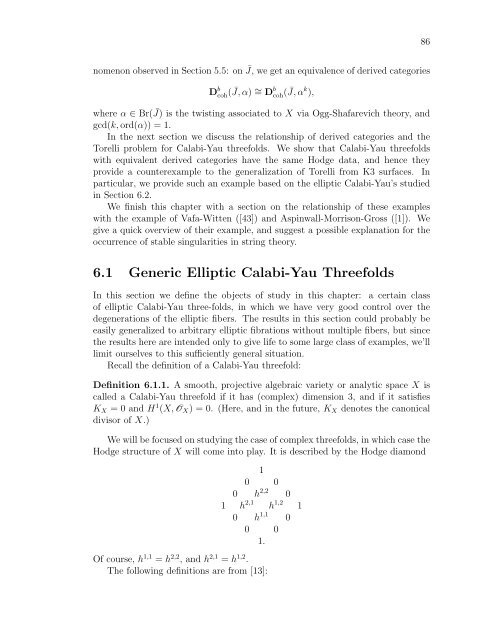derived categories of twisted sheaves on calabi-yau manifolds
derived categories of twisted sheaves on calabi-yau manifolds
derived categories of twisted sheaves on calabi-yau manifolds
You also want an ePaper? Increase the reach of your titles
YUMPU automatically turns print PDFs into web optimized ePapers that Google loves.
nomen<strong>on</strong> observed in Secti<strong>on</strong> 5.5: <strong>on</strong> ¯ J, we get an equivalence <str<strong>on</strong>g>of</str<strong>on</strong>g> <str<strong>on</strong>g>derived</str<strong>on</strong>g> <str<strong>on</strong>g>categories</str<strong>on</strong>g><br />
D b coh( ¯ J, α) ∼ = D b coh( ¯ J, α k ),<br />
where α ∈ Br( ¯ J) is the twisting associated to X via Ogg-Shafarevich theory, and<br />
gcd(k, ord(α)) = 1.<br />
In the next secti<strong>on</strong> we discuss the relati<strong>on</strong>ship <str<strong>on</strong>g>of</str<strong>on</strong>g> <str<strong>on</strong>g>derived</str<strong>on</strong>g> <str<strong>on</strong>g>categories</str<strong>on</strong>g> and the<br />
Torelli problem for Calabi-Yau threefolds. We show that Calabi-Yau threefolds<br />
with equivalent <str<strong>on</strong>g>derived</str<strong>on</strong>g> <str<strong>on</strong>g>categories</str<strong>on</strong>g> have the same Hodge data, and hence they<br />
provide a counterexample to the generalizati<strong>on</strong> <str<strong>on</strong>g>of</str<strong>on</strong>g> Torelli from K3 surfaces. In<br />
particular, we provide such an example based <strong>on</strong> the elliptic Calabi-Yau’s studied<br />
in Secti<strong>on</strong> 6.2.<br />
We finish this chapter with a secti<strong>on</strong> <strong>on</strong> the relati<strong>on</strong>ship <str<strong>on</strong>g>of</str<strong>on</strong>g> these examples<br />
with the example <str<strong>on</strong>g>of</str<strong>on</strong>g> Vafa-Witten ([43]) and Aspinwall-Morris<strong>on</strong>-Gross ([1]). We<br />
give a quick overview <str<strong>on</strong>g>of</str<strong>on</strong>g> their example, and suggest a possible explanati<strong>on</strong> for the<br />
occurrence <str<strong>on</strong>g>of</str<strong>on</strong>g> stable singularities in string theory.<br />
6.1 Generic Elliptic Calabi-Yau Threefolds<br />
In this secti<strong>on</strong> we define the objects <str<strong>on</strong>g>of</str<strong>on</strong>g> study in this chapter: a certain class<br />
<str<strong>on</strong>g>of</str<strong>on</strong>g> elliptic Calabi-Yau three-folds, in which we have very good c<strong>on</strong>trol over the<br />
degenerati<strong>on</strong>s <str<strong>on</strong>g>of</str<strong>on</strong>g> the elliptic fibers. The results in this secti<strong>on</strong> could probably be<br />
easily generalized to arbitrary elliptic fibrati<strong>on</strong>s without multiple fibers, but since<br />
the results here are intended <strong>on</strong>ly to give life to some large class <str<strong>on</strong>g>of</str<strong>on</strong>g> examples, we’ll<br />
limit ourselves to this sufficiently general situati<strong>on</strong>.<br />
Recall the definiti<strong>on</strong> <str<strong>on</strong>g>of</str<strong>on</strong>g> a Calabi-Yau threefold:<br />
Definiti<strong>on</strong> 6.1.1. A smooth, projective algebraic variety or analytic space X is<br />
called a Calabi-Yau threefold if it has (complex) dimensi<strong>on</strong> 3, and if it satisfies<br />
KX = 0 and H 1 (X, OX) = 0. (Here, and in the future, KX denotes the can<strong>on</strong>ical<br />
divisor <str<strong>on</strong>g>of</str<strong>on</strong>g> X.)<br />
We will be focused <strong>on</strong> studying the case <str<strong>on</strong>g>of</str<strong>on</strong>g> complex threefolds, in which case the<br />
Hodge structure <str<strong>on</strong>g>of</str<strong>on</strong>g> X will come into play. It is described by the Hodge diam<strong>on</strong>d<br />
1<br />
0 0<br />
0 h 2,2<br />
1 h 2,1<br />
h 1,2<br />
0 h 1,1<br />
0 0<br />
1.<br />
Of course, h 1,1 = h 2,2 , and h 2,1 = h 1,2 .<br />
The following definiti<strong>on</strong>s are from [13]:<br />
0<br />
0<br />
1<br />
86
















